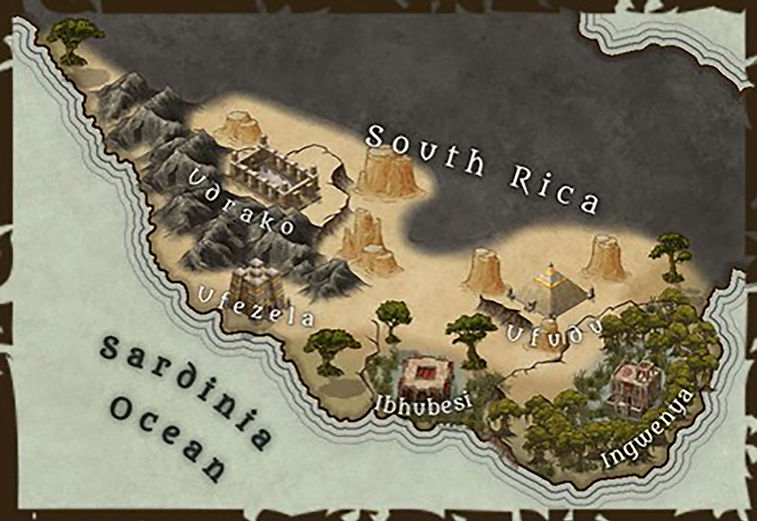


South Rica
The true origins of South Rica remain veiled in mystery, leaving historians to grapple with the uncertainties of its early history. The story begins around 2025 BCD, a time when foreign settlers embarked on a journey from a distant land, a nation situated to the south of the fabled Midgardum. These intrepid explorers navigated through uncharted territories, braving treacherous seas and dense, unyielding forests until they reached a lush, vibrant land teeming with life.
Upon their arrival, the settlers were greeted by a landscape unlike any they had ever seen. Towering trees, their canopies forming a dense, emerald roof, stretched as far as the eye could see. Rivers crisscrossed the land, their waters shimmering under the sun, providing sustenance and a means of transportation. The air was thick with the hum of wildlife, a symphony of birds, insects, and beasts that called this place home.
The settlers, awed by the richness and fertility of the land, decided to establish a new home here. They named this verdant paradise Jungla Mojada, or "Wet Jungle," a testament to the lush, rain-soaked forests that enveloped the region. They built their settlements amidst the towering trees, using the abundant natural resources to create a thriving community. Their presence marked the beginning of a new chapter in the land's history, one that would lay the foundations for the country we now know as South Rica.
As the years passed, the settlers' influence began to shape the land. They cultivated crops, developed trade routes, and formed alliances with the native inhabitants. The legacy of these early pioneers is woven into the very fabric of South Rica's identity, their story a testament to human resilience and the enduring spirit of exploration. While much of their history remains shrouded in mystery, the echoes of their journey and the land they named Jungla Mojada continue to resonate through the ages, a poignant reminder of the unknown origins that still intrigue and inspire us today.
In 2025 BCD, a significant event marked the beginning of South Rica's recorded history. Foreign settlers, originating from a nation south of Midgardum, embarked on a journey that led them to the region now known as South Rica. These settlers, drawn by the promise of fertile lands and new opportunities, named their newfound home Jungla Mojada, or "Wet Jungle," a name that reflected the lush, verdant landscapes they encountered.
During this time, South Rica found itself entangled in frequent conflicts with a formidable alliance known as the Maverick Four. This alliance consisted of The Egon Empire, The Etrus Empire, The Hell Rider Militia, and The Molim Empire, all of which were dominant powers of their era. The region witnessed a relentless cycle of warfare and bloodshed primarily among these four powers, leaving its ancient history clouded due to the lack of concrete evidence.
The Egon Empire, one of the key players in the Maverick Four, sought to expand its influence through military might. Renowned for its disciplined army and strategic prowess, the Egon Empire relentlessly pursued territorial expansion, often clashing with neighboring regions, including South Rica. The Egon forces were known for their formidable infantry and innovative siege tactics, which enabled them to conquer and subjugate many territories.
In contrast, the Etrus Empire focused on cultural sophistication and economic prosperity. The Etrus were renowned for their advancements in art, architecture, and trade. Their cities were centers of learning and culture, attracting scholars, artists, and merchants from far and wide. Despite their emphasis on culture, the Etrus were not averse to using military force to protect their interests and expand their influence, leading to frequent conflicts with their neighbors, including South Rica.
The Hell Rider Militia, another member of the Maverick Four, excelled in guerrilla tactics and cavalry assaults. Unlike the more structured armies of the Egon and Etrus Empires, the Hell Riders relied on speed, mobility, and surprise attacks. Their hit-and-run tactics wreaked havoc on their enemies, including the South Rican settlers. The Hell Riders' unpredictability and ruthless efficiency made them a formidable foe in the region.
Lastly, the Molim Empire aimed to secure dominance through innovation and military superiority. The Molim were known for their advanced technology and innovative weaponry. Their engineers and scientists developed cutting-edge tools of war, giving them a significant advantage on the battlefield. The Molim's quest for dominance often brought them into conflict with the other members of the Maverick Four and South Rica.
South Rica bore the consequences of these competing powers' struggles, experiencing numerous battles, sieges, and conflicts that shaped its physical landscape and societal fabric. The region oscillated between periods of foreign rule and fleeting moments of independence during this chaotic era. Each battle and invasion left a mark on South Rica, influencing its development and the evolution of its society.
The constant warfare and invasions led to profound societal changes and political shifts in South Rica. The settlers had to adapt to the ever-changing dynamics of power and conflict. The need for defense and survival fostered a warrior culture among the South Ricans, who became adept at defending their territory against various adversaries. Over time, this resilience became a defining characteristic of the South Rican people.
Despite the conflicts, the interactions with the Maverick Four also brought about cultural exchange and influence. The settlers of South Rica were exposed to the diverse cultures, technologies, and traditions of their adversaries. This exchange enriched South Rican society, contributing to the development of a unique and multifaceted culture that blended elements from different civilizations.
Unfortunately, due to the scarcity of reliable historical records and the passage of time, South Rica's ancient history remains obscured. Accounts passed down through generations often blend with legends and folklore, making it challenging for historians to unravel the true narrative of this enigmatic past. As a result, speculation and conjecture continue to add to the allure of South Rica's mysterious origins.
Until 1981 PC, South Rica followed a monarchical system, where the head of state, known as the monarch, held their position for life or until voluntarily stepping down. The country's governance was characterized by a unique arrangement where each city functioned as an autonomous region, lacking a strong sense of national unity. Consequently, South Rica was divided into five distinct monarchies, with each monarchy governing a specific region.
Within the borders of South Rica, the five monarchies exercised their authority independently, making decisions and administering their respective territories according to their inhabitants' needs and preferences. This decentralized system allowed for localized governance but also led to disparities in economic development, social policies, and overall cohesion among the different regions. The absence of a centralized governing body hindered the establishment of a unified national identity.
Although the monarchical structure provided stability and continuity as ruling monarchs held their positions until abdication or death, it also led to a recurring pattern of conflicts among the individual cities. Persistent warfare resulted in frequent changes in leadership, making leadership positions precarious and hindering the establishment of long-term stability and unity within the nation. The battles and power struggles between the cities of South Rica created an environment of uncertainty and instability. Rulers constantly had to defend their authority against rival factions, and this perpetual state of war hindered the implementation of long-term plans, cohesive policies, and the overall progress of the nation.
As South Rica's history unfolds, researchers and historians continue to explore archaeological sites, study artifacts, and preserve oral traditions to shed light on the remarkable journey of this enigmatic land. Despite the challenges posed by its mysterious origins and complex history, South Rica's rich cultural heritage and diverse traditions serve as a testament to the resilience of its people throughout the ages.
Archaeologists have unearthed numerous artifacts and ruins that provide glimpses into South Rica's past. These discoveries offer valuable insights into the daily lives, customs, and technologies of the ancient South Ricans. From pottery and tools to remnants of ancient structures, each find contributes to the growing body of knowledge about this enigmatic land.
Oral traditions and folklore play a crucial role in preserving South Rica's history. Stories passed down through generations provide a window into the beliefs, values, and experiences of the South Rican people. While these accounts often blend fact and fiction, they offer a rich tapestry of cultural heritage that historians and researchers strive to unravel.
Modern historians and researchers continue to develop new interpretations and theories about South Rica's origins and early history. Advances in technology, such as DNA analysis and remote sensing, have opened new avenues for exploration and discovery. These tools allow researchers to piece together fragments of evidence, gradually unveiling the mysteries that have long surrounded South Rica.
Despite the uncertainties and gaps in its historical record, South Rica's legacy endures. The resilience and adaptability of its people, forged in the crucible of conflict and adversity, continue to shape the nation's identity. South Rica's rich cultural heritage, diverse traditions, and unique history serve as a source of pride and inspiration for its citizens.
The cultural resilience of South Rica is evident in its vibrant traditions, festivals, and artistic expressions. The blend of influences from various civilizations has created a unique cultural mosaic that is celebrated and cherished by the South Rican people. Traditional music, dance, and art reflect the nation's rich heritage and the enduring spirit of its inhabitants.
The quest for a unified national identity has been a recurring theme in South Rica's history. Despite the challenges posed by its decentralized governance and frequent conflicts, the people of South Rica have always aspired to forge a sense of unity and common purpose. This aspiration has manifested in various forms, from movements for independence to efforts to establish a centralized government.
The true origins of South Rica remain shrouded in mystery, but the journey to uncover its past continues. Through the efforts of researchers, historians, and archaeologists, new discoveries and insights are gradually emerging. The complex history of South Rica, marked by conflict, cultural exchange, and resilience, is a testament to the enduring spirit of its people. As the nation moves forward, it carries with it the rich legacy of its enigmatic past, embracing the lessons and experiences that have shaped its unique identity.





